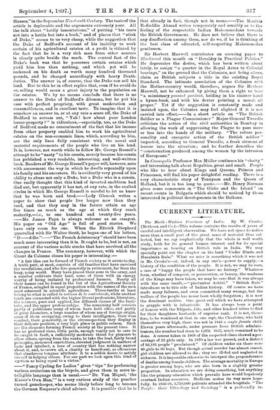CURRENT LITERATURE.
The North - Western Provinces of India. By W. Crooke. (Methuen and Co.)—This volume contains the results of years of careful and intelligent observation. We have not space to notice more than a small part of the great mass of material thus col- lected, but we say emphatically that the whole is well worth study, both for its general human interest and for its special importance as bearing on British rule in India. We may specially point out the chapter on the land "Under Hindu and Musalman Rule." What we miss is something which it was not in Mr. Crooke's—or, indeed, in any one's—power to supply,—a history of the condition of the people. It is not, we may be sure, a case of "happy the people that have no history." Whatever form, whether of conquest, or persecution, or luxury, the madness of the Kings may have taken, we may be sure that it was always with the same result,—" plectuntur Achivi." "British Rule" introduces us to this side of Indian history. Of course we have made many failures, and even committed many wrongs, but the welfare of the people has never been wholly forgotten ; it is now the dominant motive. One great evil which we have attempted to grapple with is infanticide. It has always been a point of honour with the Rijputs, Jilts, and other kindred tribes to find for their daughters husbands of superior rank. It is not, there- fore, to be wondered at that in one sept, the Chauhins, who held themselves very high, there was not in 1843 a single female child. Eleven years afterwards, under pressure from British adminis- trators, the number had risen to 1,079. Still, much remained to be done. A census taken in 1868 of the suspected clans showed a per- centage of 22 girls only. In 1870 a law was passed, and a district of 92,185 people "proclaimed." Of children under six there were 40 girls to 60 boys. But though actual murder has almost ceased, girl children are allowed to die ; they are ill-fed and neglected in sickness. It is impossible otherwise to interpret the preponderance of deaths among female children. The average mortality in Europe is greater among boys, who are also born in a slightly greater proportion. In education we are doing something, but anything like the primary education which prevails here would hopelessly overtook Indian resources. Medicine makes its way more hope- fully. In 1893-94, 3,750,000 patients attended the hospitals. "The People : their Ethnology and Sociology" is a profoundly in-
teresting chapter. There are races in the .North-West which give us a good idea of prehistoric man. The Korwas of Mirzapur are a tribe of the most savage habits, troglodytes, each household living apart, without agriculture of any kind or domestic animals, living on roots and the fruits of jungle trees. From this lowest stage the other tribes rise in regular gradation. Mr. Crooke tells us, that as far at least as the North-West is con- cerned, the marriage of widows is common. Out of forty million Hindus, three-fourths permit, or even encourage, the practice. Of course, the Mahommedans do the same. The particulars given of the food of the people are notable. In Bareilly the average amount of food consumed is 2.10 lb. of grain and pulses, with 142 grains of salt (a dessert-spoon well filled). The low caste Hindu fares better than the high-caste where both are poor. The average consumption of sugar is about 40 lb. per head. The clothing of a man, wife, and three children costs about 8s. The population averages six hundred and seventy-seven to each square mile of cultivation. In the purely rural parts of England the density is much smaller.



































 Previous page
Previous page